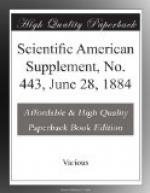Out of fifty-eight cases of rise of temperature the rate of ordinary corrosion was increased in every instance except one, and that was only a feeble exception—the increase of corrosion from 60 deg. to 160 deg. F. with different metals was extremely variable, and was from 1.5 to 321.6 times. Whether a metal increased or decreased in thermo-electromotive force by being heated, it increased in rapidity of corrosion. The proportions in which the most corroded metal was also the most thermo-electro-positive one was 65.57 per cent. in liquids at 60 deg. F., and 69.12 in the same liquids at 160 deg. F.; and the proportion in which it was the most chemico-electro-positive at 60 F. was 84.44 per cent, and at 160 deg. F. 80.77 per cent. The proportion of cases therefore in which the most chemico-electro-negative metal was the most corroded one increased from 15.56 to 19.23 per cent, by a rise of temperature of 100 deg. F. Comparison of these proportions shows that corrosion usually influenced in a greater degree chemico-electric rather than thermo-electric actions of metals in liquids. Not only was the relative number of cases in which the volta-negative metal was the most corroded increased by rise of temperature, but also the average relative loss by corrosion of the negative to that of the positive one was increased from 3.11 to 6.32.
The explanation most consistent with all the various results and conclusions is a kinetic one: That metals and electrolytes are throughout their masses in a state of molecular vibration. That the molecules of those substances, being frictionless bodies in a frictionless medium, and their motion not being dissipated by conduction or radiation, continue incessantly in motion until some cause arises to prevent them. That each metal (or electrolyte), when unequally heated, has to a certain extent an unlike class of motions in its differently heated parts, and behaves in those parts somewhat like two metals (or electrolytes), and those unlike motions are enabled, through the intermediate conducting portion of the substance, to render those parts electro-polar. That every different metal and electrolyte has a different class of motions, and in consequence of this, they also, by contact alone with each other at the same temperature, become electro-polar. The molecular motion of each different substance also increases at a different rate by rise of temperature.
This theory is equally in agreement with the chemico-electric results. In accordance with it, when in the case of a metal and an electrolyte, the two classes of motions are sufficiently unlike, chemical corrosion of the metal by the liquid takes place, and the voltaic current originated by inherent molecular motion, under the condition of contact, is maintained by the portions of motion lost by the metal and liquid during the act of uniting together. Corrosion therefore is an effect of molecular motion, and is one of the modes by which that motion is converted into and produces electric current.




